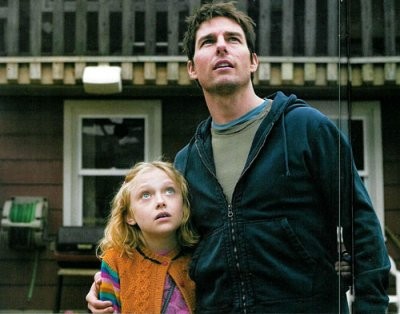

Having the house built in Bayonne for the lead character of the new Steven Spielberg film, "War of the Worlds," helped define the back story while leaving many of the other more adventurous parts for elsewhere in the state and the country.
For me, it has been a curious adventure seeking to make out who the person Tom Cruise is supposed to be playing, picking out clues from the glimpses of sets - one vast puzzle that Sherlock Holmes might find interesting.
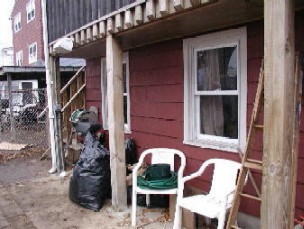
So in wandering through the worlds Spielberg constructed as the base of the character Cruise was to play, each item seemed to have meaning. Although slated as located in the Iron Bound section of Newark, the reconstruction of homes in Bayonne seemed dedicated a reflect Ferrier's working class world. This was reflected in each of the sets I visits from the very public Harrington's Garage built on a ball field at the foot of the Bayonne bridge to the interior shots of Henry Sanchez's Kennedy Boulevard home a few blocks away.
Spielberg crews had not completely transformed Sanchez's actual home, but the exteriors of the block and his garage, building instead studio sets that had that basic theme of working class Sanchez actual home had long ago evolved out of into an upper middle class interior.
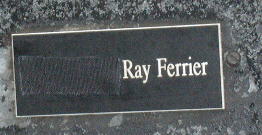
Dabbling in working class themes is nothing new for Spielberg. Many of his films sought to duplicate the working class life, most notably the desperate world depicted in Close Encounters. The working class in American films, however, has become something of legend, the way the Wild West became during that spat of Westerns made in the early days of filming. Film makings often sketch the outlines of that world, but frequently fall into caricature than character in the telling of the story.
Few really have succeeded in capturing the odd mixture of pride and desperation of the actual working class, that sense of Thoreau's quiet desperation which men and women live their lives, men coming and going from jobs they had, women stuck in homes raising children they sometimes can't control. And in this world where as children each dreamed of some greater achievement life has denied them.
While for the most part, Spielberg left the fronts of the Bayonne homes in tact, his crews savaged the more middle class back yards - removing swimming pools, lawn furniture, even well-maintained fences to replace each with laundry lines, cheap plastic or metal furniture and charcoal burning barbeques lacking only the scene of lighter fluid to make real. Even the plush lawns had to go, covered over with plywood and turf, and then spread with crab grass staff had to wet down daily in a desperate effort to keep it alive long enough for the scenes to be shot.
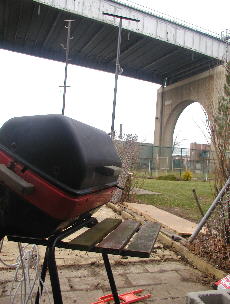
Wandering behind these yards, looking over the details of rusted, sagging fences, you could feel the intensity of character Spielberg tried to convey - of a working class Ferrier struggling to keep his and his children's lives together. This was even more evident in the garage where tools decorate the walls, yet in something of a shambles, each item left where it was last laid, and waiting for a moment the moment when Ferrier might be able to pick up where he left off.
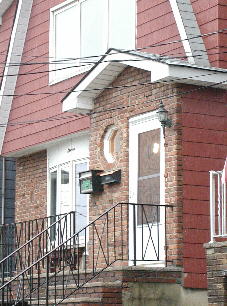
Time is always an issue for working class people. And while I have no real idea as to what the Cruise character actually did for a living - perhaps worked full time as a mechanic at the Harrington Garage down the street - but typical of such men they usually arrived home too weary from work to think of anything but television. And yet, the garage and the interior sets show a dedication to maintaining a ordinary life - a washer and perhaps dryer in the rear of the house, a refrigerator full of food which he must cook for his kids, bedrooms for the kids that bear signs for a better life, such as the globe in one room and the effort to take the edge of the harsh elements of his world with stuffed animals and odd bits of color to give shape to an otherwise drab world.
Even without the invasion from outer space, Ferrier is a hero, struggling against the immensity of how own life.
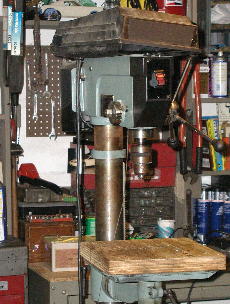
But there are hints in the sets that Ferrier (aka Tom Cruise) is also obsessed, fitting the pattern of many of Spielberg's better central character. Instead of tearing up the fence corralling ducks and yanking out the shrubs as Spielberg's hero of Close Encounters does, Ferrier fills his garage with tools, working to reconstruct his black Mustang convertible - perhaps a conscious symbol for everyday man's need for dreams in order to make the mundane life bearable.
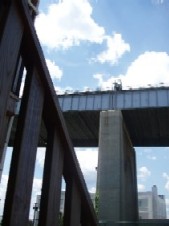
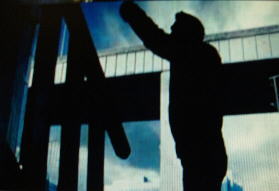
Ferrier, of course, loved cars. His living room is filled with automotive magazines and parts, and a hard hat from some job that the details of the scene won't explain. But he also loves things that go fast, and in the movie, he apparently loves riding a motorcycle as well as fast cars. In several scenes Cruise along with his double film repeatedly filmed scenes of Ferrier roaring into his driveway and coming to an abrupt halt. Then Cruise emerges from the car with a devil-may-care attitude as if he had not done anything reckless, easing into the usual mundane routines such as taking out the trash.
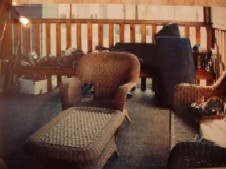

As typical of working class, Ferrier wears jeans and a jacket for many of the scenes filmed in Bayonne, hanging up his jacket on wall hooks just inside the door after he has charged up the front steps from the driveway. Ferrier lives in a single-family, three-story house with gym equipment in the basement behind his garage full of tools, newspapers and auto magazines strewn on the surface of his wooden living room furniture.


The Kennedy Boulevard house was largely constructed for exterior shots. Even the interview redesign of some of the rooms such as the living room constructed in the front first floor and the dinning room installed in a rear den of the house were meant largely for a backdrop to Cruise or his kids coming and going from the room so that the camera situated outside the building could pick up the images of the room when the character entered and cameras inside the room recorded the actors coming in from that angle.

The rooms themselves were located about a mile away on sound states where the house was broken into three floors for easy filming. Traveling through these rooms, you walk through Ray Ferrier's life, with the icons of a working class from refrigerator magnets to slick-covered hotrod magazines. Ferrier apparently sees himself as a hot-rodder. But he appears to be a lonely man.

This assessment differs slightly from prior writings as details of critical scenes emerge, and it is still unclear as to whether or not Ferrier has custody of his kids or whether or not the invasion hits during one of his court allowed weekend custodies. If Close Encounters is any indication, Ferrier may be a little too obsessed for permanent custody and the ragged edge of the interior scene are those of a typical working male left to his own resources. You might even find ash trays thick with cigarette butts (perhaps not considering the excise equipment), empty beer cans and assortment of laundry - clean but not folded or dirty but not in the hamper.
If the children are not living with Ray, then this adds to his possible obsession, since the kids rooms still have the things that you would find in a child's room, from globe to stuffed animal.
Although Ferrier still pines for his ex-wife, Mary Ann, she is remained and pregnant with her new husband's child. Some of the more emotional scenes depict her dropping off their daughter and the daughter running up the driveway into Ferrier's arms for his weekend custody or coming from a weekend with her.
Who is Ray Ferrier?
Like many of Spielberg's heroes, he is a man possess, racked with potential for failure, yet inflated by hope, and soon destined to face the biggest challenge of his life - and invasion from outer space.
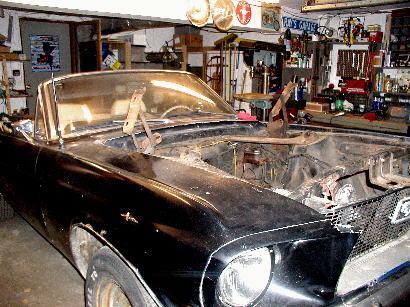
The center piece of the Bayonne shoot is also the center piece of the movie, in which conflict with overwhelming force, Ferrier manages to pull his shattered life together to oppose the invasion of the aliens. This is symbolically represented by the Mustang - which he supposedly assembles in time for the car to become a critical agent in his escape. Props apparently had several black Mustang convertibles - and the pivotal scene has Cruise being chased through the streets of Bayonne. The gas station at the end of the block where Ferrier lives as well as the block of houses that formed the set for home scene will all explode via special effects. The car chase likely ends with the crash of his car and with the chase scene continuing on foot through local back yards. This is all somewhat symbolic - and a freshman college literature course might depict the destruction of the house and car as the ultimate change of worlds, leaving him propelled towards some unknown future. If he survives, he will not be the same man he was before the aliens invaded. That world ceased to exist.
